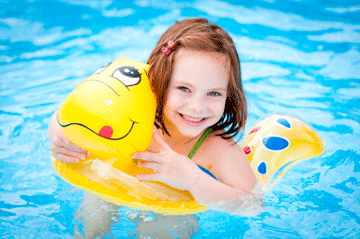- Home
- Loss Control
- Loss Control Insights
- Chemical Safety for Community Swimming Pools (Updated June 2021)
Pool chemicals, such as chlorine and muriatic acid, are necessary to keep the water safe for swimming, but these same chemicals can be very dangerous. If mishandled, pool chemicals can cause respiratory problems, eye injuries and skin injuries. According to the Centers for Disease Control and Prevention (CDC), pool chemical injuries lead to more than 4,500 emergency department visits annually. But you can protect your employees and pool patrons by understanding how to safely use and store them.
The Basics of Pool Chemicals
Most pools disinfect water using chlorine-based products. These chemicals come in liquid, granular or tablet form and are very concentrated. Chlorine can be highly reactive and a strong oxidizer, so safe usage and storage is important to prevent a dangerous chemical reaction. Chemical reactions can generate a variety of hazards, including poisonous fumes, caustic liquids and even explosions.What You Need to Know About Handling Pool Chemicals
Any time you’re working with a chemical, you should read the product label and follow all directions. You can also check out the safety data sheet (SDS) for details on chemical dangers, possible reactivity concerns and instructions for safely cleaning up a spill.While handling the chemical, protect yourself as directed by the product label. Wear goggles or glasses with side shields and chemical-resistant gloves, and if working with liquid chemicals, wear a face shield in addition to eye protection. Make sure you’re in a well-ventilated area whenever you handle the chemicals and avoid breathing in any dust or fumes.
How to Mix Pool Chemicals
When you’re ready to add chemicals to the water, you should always follow the package directions. Only open one chemical at a time and close the container before opening another. If you’re using a powdered chemical, make sure the wind is blowing away from you to avoid unintended inhalation or contact with skin and eyes. Only pre-dissolve chemicals if the instructions specifically call for it, and make sure you always add the chemical to the pool water instead of the other way around—never add water to the chemical.Additionally, you should never use the same scoop for all chemicals. Each chemical must have its own dedicated measuring cup or scoop to prevent cross-contamination that can lead to a reaction. And don’t forget to make sure the scoop is completely dry before returning it to a chemical container.
How to Safely Store Pool Chemicals
Product labels provide information on how to safely store individual chemicals, but these general guidelines offer a good start:- Keep storage area well ventilated, cool and away from sunlight as UV light can degrade chemicals
- Secure the storage area so only authorized employees have access
- Ensure all chemical containers are in good condition with no cracks or leaks
- Do not place chemical containers and bags on the floor and never reuse empty containers
- Make sure employees don’t eat or drink in the storage area as sodas and other liquids can trigger a reaction
- Keep dry chemicals in a dry place; something as minor as raindrops could cause a dangerous reaction
Ideally, reactive chemicals should be stored in separate rooms. If that’s not possible, make sure they are stored with plenty of space between them in a well-ventilated area. Additionally, liquid chemicals should never be stored above dry chemicals. If the liquid container were to spring a leak, there is an immediate risk of it encountering the dry chemicals below, causing a dangerous reaction. You may want to consider investing in spill containment pallets or berms, which are designed to contain leaks, drips or ruptures from chemical storage containers.
DANGEROUS CHEMICAL COMBINATIONS
| To avoid dangerous chemical reactions, make sure you keep plenty of distance between these chemical pairs. | ||
| Liquid Chemicals | and | Dry Chemicals |
| Chlorine Products | and | Acids |
| Inorganic Chlorinating Agents (calcium hypochlorite, lithium hypochlorite, sodium hypochlorite) | and | Organic Chlorinating Agents (trichloroisocyanuric acid, potassium dichlorisocyanurate, sodium dichlorocyanurate) |
| Chlorine Products | and | Ammonia and Other Cleaning Products |
What to do if a Pool Chemical Accident Occurs
If a pool chemical is spilled, make sure you respond immediately. Pool chemicals are corrosive and can lead to burns, lung injuries and even fatalities. Follow your emergency chemical spill response plan and the product’s SDS to safely clean up the spill. If the product splashes or comes in contact with the eyes or skin, flush the areas with large amounts of water and call poison control or 911 for emergency assistance and medical treatment.Find More Online
Get in touch
Need help? We’re here for you! Whether you have questions or need personalized assistance, your local office is ready to support you.
Loss Control Insights
Stay informed with the latest news and receive actionable safety tips, all carefully curated by our team of experts.
